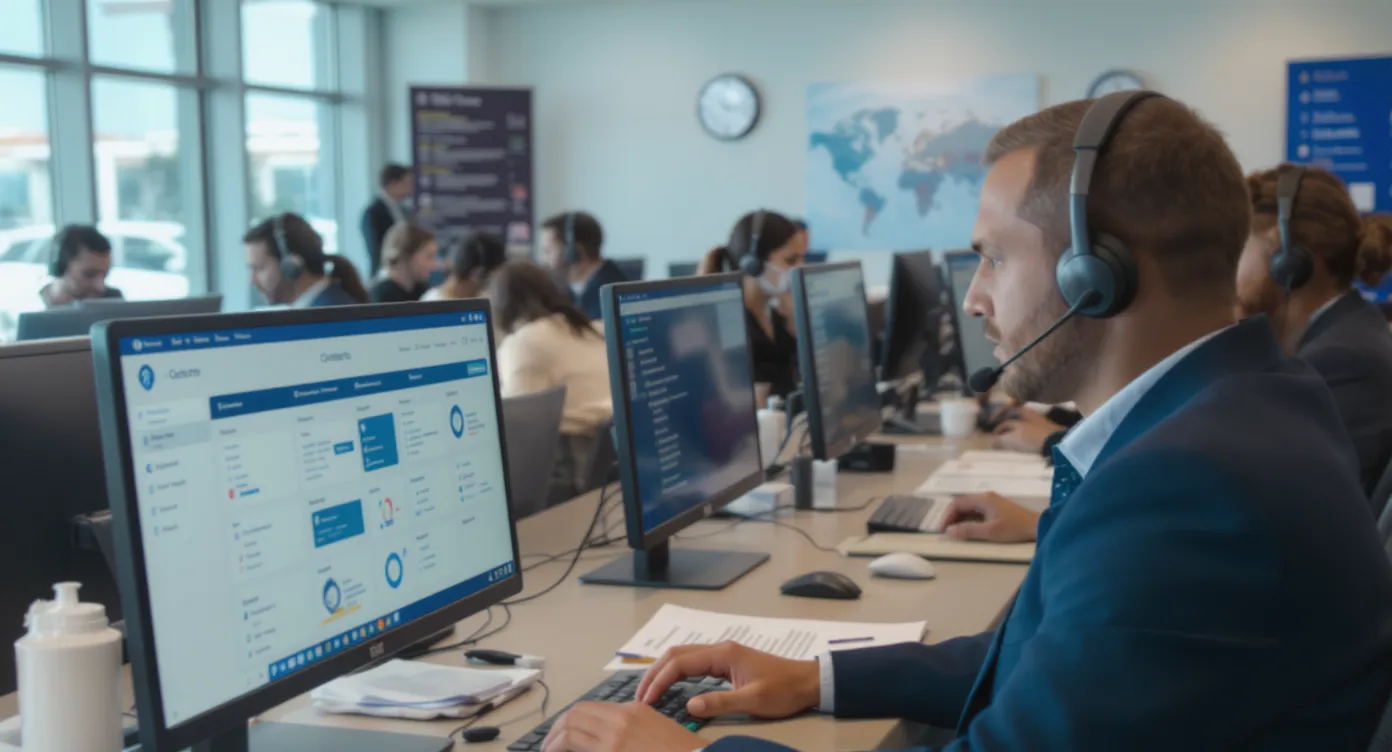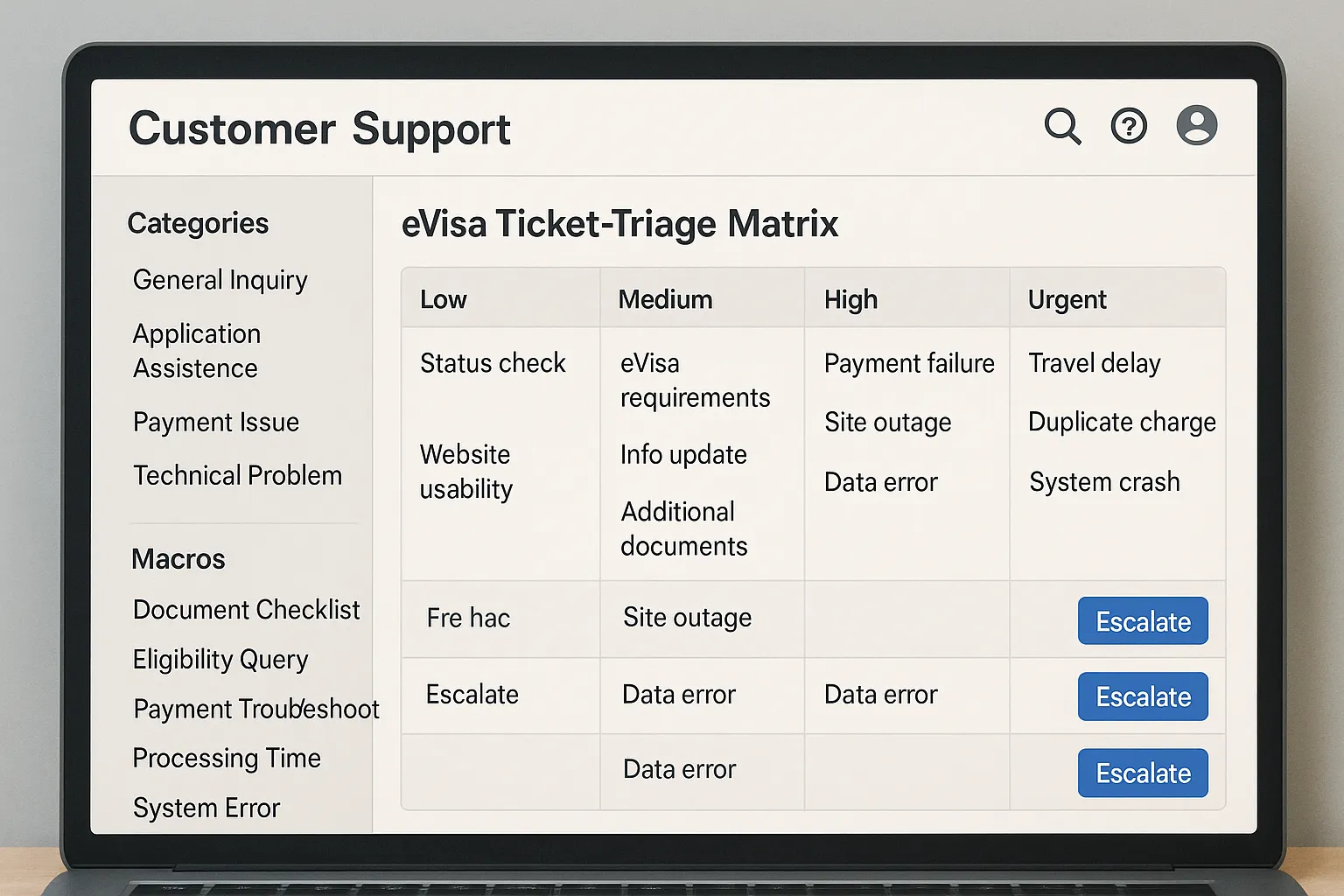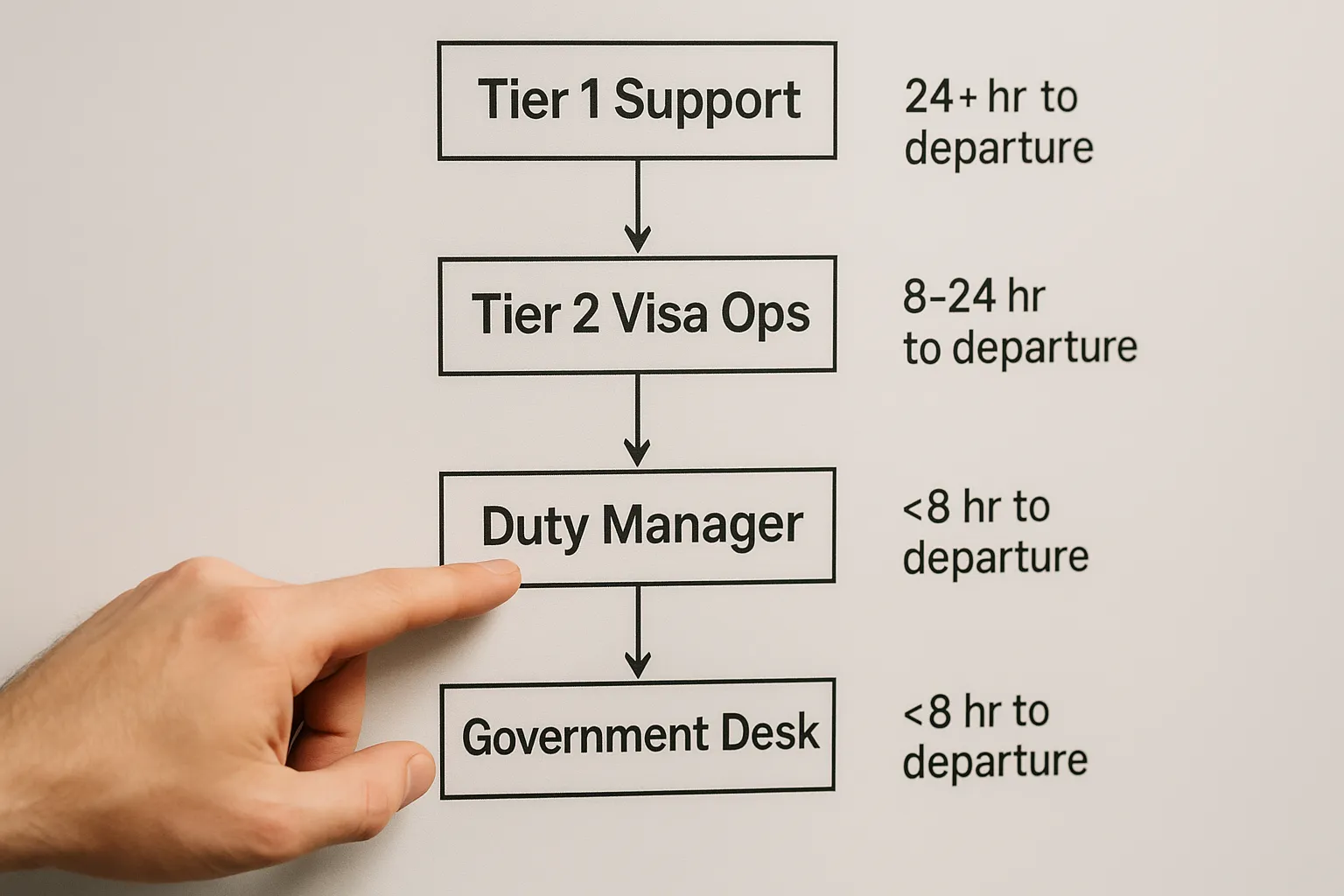Customer Support Playbooks for eVisa Issues: Scripts, Macros, and Escalation Paths

Modern travelers expect answers in minutes, not hours—especially when a missing eVisa can derail an entire trip. Yet most airline, OTA, and tour-operator contact centers still treat visa queries as edge cases, forcing agents to scramble for policy PDFs or call government hotlines. The result? Long handle times, poor CSAT, and lost bookings.
In this guide you will find a complete customer-support playbook for eVisa issues, including ready-to-copy scripts, ticket macros, and clear escalation paths that fit neatly inside tools like Zendesk, Freshdesk, or Salesforce Service Cloud. Whether you run a 10-seat desk or a global 24/7 operation, these templates will help you raise first-contact resolution (FCR), trim average handle time (AHT), and even uncover new ancillary-revenue moments.
Why eVisa Support Deserves Its Own Playbook
- Compliance risk: Airlines can be fined up to US$3,200 per passenger for boarding travelers without the correct documentation (IATA TIMATIC data, 2024).
- Abandonment impact: SimpleVisa research across 9.4 million bookings shows that 42 percent of abandoned visa forms could have been saved with proactive agent intervention.
- Satisfaction lift: Zendesk’s 2025 Benchmark reports a 17 percent CSAT gap between queries solved in one touch and those requiring a second follow-up.
The message is clear: mastering visa support is good for travelers and your bottom line.
Foundation: A Ticket-Triage Matrix
Before you write a single macro, map every visa-related ticket into a small set of categories. This lets agents choose the correct response instantly and decide whether escalation is needed.
| Category | Typical Issues | Skill Required | Target FCR | Example Macro |
|---|---|---|---|---|
| Eligibility | “Do I need a visa for Kenya?” | Basic | 85 % | VIS-ELIG |
| Application | Upload errors, payment failures | Intermediate | 80 % | VIS-APP |
| Status & Tracking | “Where is my eVisa?” | Basic | 90 % | VIS-STAT |
| Denied or Rejected | Clarification, re-application | Advanced | 50 % | VIS-DEN |
| Border & Airline Check-in | Visa not recognised at gate | Tier-2 | 60 % | VIS-BRD |
Create an internal “cheat sheet” that lists the above matrix plus relevant policy links (for SimpleVisa users, the Partner Portal’s Docs tab already surfaces this information). Agents can then attach the right macro with two clicks.

Macro Anatomy: Best-Practice Blueprint
A high-performing visa macro should contain six elements:
- Personalized greeting using the traveler’s first name
- Empathy statement acknowledging urgency
- One-sentence summary of the issue
- Actionable next steps (bulleted)
- Reassurance or compliance note
- Upsell or self-service link (optional)
Example Macro VIS-STAT: “Where Is My Visa?”
Hi {{first_name}},
I understand it’s stressful to wait for your travel documents so close to your departure.
Good news—your application for the India eVisa is **currently in the final review stage**. Based on recent approvals, we expect a decision within the next 12 hours.
What happens next:
- As soon as the eVisa is approved, you’ll receive an email with a PDF copy.
- We’ll also push a boarding-ready version to your SimpleVisa Wallet in the app.
- If the authority requests additional info, we’ll notify you instantly with clear instructions.
Rest assured, more than 98 percent of applications at this stage are approved without extra action.
Safe travels,
{{agent_name}}
{{company}}
Notice the macro is destination-aware (“India eVisa”) and expectation-setting (12 hours). Both data points can be auto-filled via the SimpleVisa API, eliminating manual edits.
Five High-Volume Scripts You Can Copy Today
Below are concise, copy-ready scripts for the most common eVisa tickets. Adapt placeholders as needed.
1. Eligibility Check (VIS-ELIG)
Hi {{first_name}},
Yes—you **do** need an electronic visa (eVisa) to enter Kenya with a {{passport_country}} passport. The online application takes about 10 minutes, and approvals typically arrive within 48 hours.
You can start immediately using this secure link: {{evisa_checkout_url}}
Need any help along the way? Just reply here and I’ll monitor your progress.
Best,
{{agent_name}}
2. Payment Failure (VIS-APP-PAY)
Hi {{first_name}},
I’m sorry your card was declined during payment. Here are three quick fixes that usually solve the problem:
- Confirm the card supports 3-D Secure (required by the issuing authority).
- Double-check that your bank hasn’t blocked foreign transactions.
- Try an alternative method such as PayPal or a different credit card.
Once the payment succeeds, your application will resume automatically—no need to refill the form.
If the issue persists after two attempts, reply with a phone number and our billing desk will call you within 30 minutes.
Regards,
{{agent_name}}
3. Document Upload Error (VIS-APP-UPLD)
Hi {{first_name}},
It looks like the system rejected your passport photo because the background was not plain white.
Quick fix:
1. Stand against a light, even background.
2. Remove any eyewear.
3. Use good lighting—no shadows.
4. Upload a JPEG under 500 KB.
You can re-upload the image here: {{secure_upload_link}}
Tip: our mobile app has an auto-crop tool that guarantees compliance.
Thanks,
{{agent_name}}
4. Visa Denied (VIS-DEN)
Hi {{first_name}},
I’m sorry your Sri Lanka eVisa was refused. The immigration officer cited **incorrect passport number** as the reason.
Good news—this error is simple to fix. Click the “Re-Apply” button in your dashboard, confirm the correct number (make sure to include all letters), and submit. Most corrected applications are approved within 24 hours.
If you prefer, I can initiate the re-application for you now. Just reply “YES” and I’ll charge the reprocess fee of USD 25 to the same card.
Let me know how you’d like to proceed.
Sincerely,
{{agent_name}}
5. Passport Number Mismatch at Boarding (VIS-BRD)
Agent Note (Internal): Customer at JFK check-in desk. Boarding in 2 h 15 m. Passport number in airline PNR ends 1234; eVisa ends 1324.
Escalate → Tier 2 Visa Ops (on-call) + Airline Liaison.
Escalation Pathways: From Tier 1 to Government Desk
Use a clear, time-bound escalation map so agents know exactly whom to involve—and when.
| Time to Departure | Primary Owner | Secondary Owner | SLA to Respond |
|---|---|---|---|
| >72 h | Tier 1 Support | – | 8 h |
| 72 h–24 h | Tier 1 Support | Tier 2 Visa Ops | 2 h |
| <24 h | Tier 2 Visa Ops | Duty Manager | 30 m |
| At airport | Duty Manager | Government Desk / Airline Liaison | Immediate |

If you already use SimpleVisa’s escalation API, you can embed these SLAs directly into your ticketing system so timers start automatically when agents change the ticket field visa_departure_window.
Escalation Checklist
- Attach all application IDs and passport scans (avoid screenshots; use the original PDFs).
- Specify departure time in local airport time zone.
- Tag with
visa_blockerso reporting dashboards can track incident volume. - Notify sales if re-booking or cancellation may be required.
Coaching Agents for Continuous Improvement
- Call-shadow new hires for 3 days using real eVisa tickets, then certify via a 10-question quiz (see our one-week training blueprint).
- Review five randomly sampled visa tickets per agent per week. Grade on accuracy, empathy, and upsell seize rate.
- Maintain a living knowledge base. Each time Tier 2 solves a novel issue, add the solution as a new macro or update an existing one.
- Track these KPIs (aligns with our KPI guide):
- Visa-related FCR (goal 80 %+)
- AHT for visa tickets (goal <8 minutes by Q2)
- Incremental ancillary revenue per visa assist (goal +US$3)
- CSAT on visa tickets (goal 4.6/5)
Leveraging SimpleVisa’s Built-In Support Tools
- Real-time status webhooks push visa decisions into your help-desk ticket, eliminating “where is my visa?” queries.
- Denial reason codes are mapped to macros, so the correct script appears automatically.
- One-click re-apply links let agents reprocess corrected applications without re-entering data.
- Agent dashboard displays country-specific SLAs and document specs to prevent mis-guidance.
If you are not yet using these features, book a 15-minute demo with our solutions team to see how they plug into Zendesk and Freshdesk with zero code.
Putting It All Together
With a tight triage matrix, dynamic macros, and clearly defined escalation paths, your support team can move from reactive fire-fighting to proactive service. Travelers get instant, accurate answers; agents spend less time digging through PDFs; finance teams see fewer refunds and higher ancillary revenue.
Start by importing the five scripts above, set up time-based escalation triggers, and benchmark your visa-ticket metrics this week. Small changes compound quickly—and your customers will notice the difference on their very next trip.